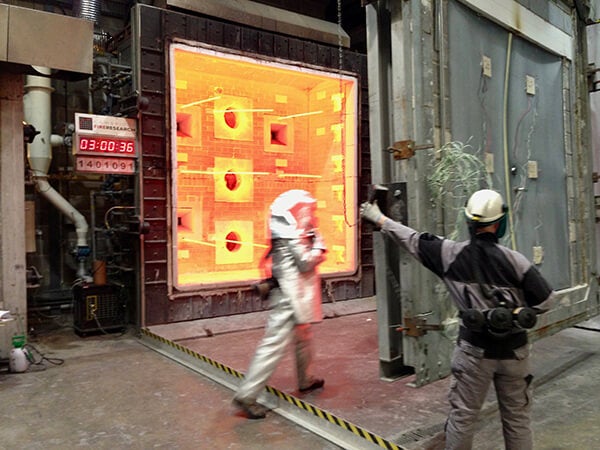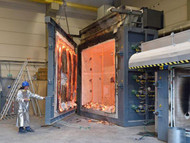Fire & Safety
Posted by Max King on 7th Jan 2022
Cold-Formed Steel buildings fire-resistant properties offer superior safety over any other construction materials reducing the fire risk to a building and retarding the spread of a fire should one occur. In high risk areas where additional resistance is required, stanchions and rafters can be fire cased or boarded to add to the integrity of the structure. A steel building can often provide significant benefits to the owner through reduced insurance costs and far improved longevity of the structure under a number of adverse conditions including fire.
The main components of a steel building are explained below with the appropriate fire ratings:
Cold-Formed Steel
Key benefits of Cold Rolled Steel Frame
Cold Formed Steel is non-combustible; it does not add to the fire load of the building. When used as the primary frame with a Single Skin or Composite Envelope, it provides a superior structure for your steel building.
- Fire protection for cold formed steel framing is typically provided by the external cladding and optional boards used for internal lining, e.g. gypsum-based boards and fire-boards.
- Fire resistance periods of up to 120 minutes are readily achievable with fire casing adding substantially to the performance.
- The amount of combustible material in a light steel framed building is much lower than in other forms of construction.
- The fire risk during construction is much lower for light steel framing than for some forms of construction due to prefabricated of all materials to reduce on-site cutting.
Single Skin Cladding
Key benefits of Single Skin Steel Cladding
Steel cladding excels in resisting ignition and is commonly used as part of a fire-resistant assembly due to that trait. Steel cladding panels, when installed over open framing or a non-flammable substrate, are rated Class A for external fire exposure—the highest rating.
- Single Skin Steel Cladding is non-combustible and will provide up to 4 hours fire integrity resistance.
- Steel wall cladding is easily repairable after cosmetic damage from small fires.
- Single Skin roof and wall profiles achieve Class 1 surface spread of flame (Euroclass B), equivalent to Class 0 surface spread of flame as described in Approved Document B. All profiles are AA rated to BS 476-3:2004 & B roof (t4) to BS EN 13501-5.
- We use the same Single Skin Steel Cladding for the outer external layer to our built up twin skin systems to ensure the highest standards in fire resistance.
Composite Cladding
Key benefits of Composite Steel Cladding
Steel Build Masters only use the best products available to ensure the safety and integrity of each building. We supply both Tata Steel Trisomet® Composite Cladding and Kingspan KS1000 RW® for complete peace-of-mind. Tata Steel and Kingspan are the European leaders in performance Steel Cladding with no other product coming close to the technical performance of each product. With Steel Build Masters you are always in safe hands.
Tata Steel and Kingspan composite panels for external cladding are firmly fixed to the structural building framework – there is no collapse. Joints are fully engineered to provider excellent air and weathertightness and also to protect the core in the event of either internal or external fire – joints do not open and expose the core. Steel facings protect the core. There is no instant release of heat load nor any rapid flashover and there is no hidden flaming or fire spread within the PIR core of the panel.
Tata Steel Trisomet®
- Trisomet® carries Grade EXT-B and EXT-A approval by the LPCB. Also Fire resistance performance of 4 hours integrity and 22 mins insulation are achievable with 40 mm and 60 mm core panels and 30 mins insulation for panels 80 mm and above. These are attained using standard fixing and sealing methods (external side-lap stitched at maximum 300 mm centres).
- The panel achieves a Grade AA rating in accordance with BS 476-3, which tests for external surface spread of flame and fire penetration (AA is the best result achievable).
- The internal surface of the panel complies with Class ‘O’ in accordance with the Building Regulations when tested to BS 476 Parts 6 & 7 and also achieves a Class B s2 rating in accordance with EN 13501-1.
Kingspan KS1000 RW®
- Reaction to Fire
Classified B-s1,d0 according to the European Reaction to Fire classification system (Euroclasses) BS EN 13501–1:2007+A1:2009 when tested on the internal liner. Please contact Technical Services for information relating to the external face. - Fire Resistance
EI15 / E90 horizontal and vertical according to BS EN 13501-2 with minimum 40mm thickness in vertical and horizonal orientations.
EI30 / E60 horizontal and vertical according to BS EN 13501-2 with minimum 80mm thickness in vertical and horizonal orientations.
- Insurer Approvals
LPS 1181 Part 1: Issue 1, series of fire growth tests for LPCB approval and is certified to LPS 1181 Grade EXT-B.
LPS 1181 Part 1: Issue 1, series of fire growth tests for LPCB approval and is certified to LPS 1181 Grade EXT-A30 with minimum 80mm thickness in vertical orientation.
LPS 1181 Part 1: Issue 1, series of fire growth tests for LPCB approval and is certified to LPS 1181 Grade EXT-A15 with minimum 40mm thickness in vertical orientation.
FM 4880 Class 1 fire rating of building panels or interior finish materials, unlimited height*
FM 4881 Class 1 exterior wall systems, unlimited height*
FM 4882 Class 1 interior wall panels in smoke sensitive occupancies (pharmaceutical manufacturing & storage areas, and food preparation &storage areas or similar occupancies)*
*2m maximum span only.


